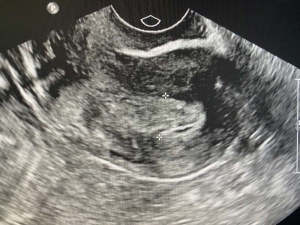Thickened Endometrium On Ultrasound in a Post Menopausal Patient
The endometrium is the lining of the uterus. The endometrium is well seen on ultrasound exams and it’s thickness is usually measured. It is seen a stripe that is brighter than the surrounding uterine tissue. it usually appears smooth and of similar consistency throughout.
In patients who are postmenopausal the thickness cutoff for abnormal is usually 5 mm especially for those women who have vaginal bleeding. The risk of cancer goes up significantly above this thickness. A thickness under 5 mm does not exclude cancer however. If there is no vaginal bleeding, then thicker cut offs have been proposed where the risk for cancer increases.
A thickened endometrium in a post menopausal patient can be due to a variety of causes. The most concerning is cancer which can appear as thickening of the lining or a mass. A thickness over 5 mm in a women who is bleeding often prompts biopsy. In more advanced cases, ultrasound can suggest involvement of the uterus adjacent to the lining called the myometrium.
Endometrial hyperplasia is a proliferation of the endometrial tissue. This can also present with vaginal bleeding. Hyperplasia can have concerning cells which may be precancerous in some cases. The appearance overlaps with that of cancer and biopsy is often needed.
Polyps of the endometrium can cause thickening which is more often focal. They are a common cause of post menopausal bleeding. The medication tamoxifen which is used to treat breast cancer can cause thickening of the endometrium often with cysts and polyps. Hormone replacement therapy can cause thickening of the endometrium.
Endometritis which is infection or inflammation of the endometrium can cause thickening. This can be seen in pelvic inflammatory disease or after medical procedures. These patients will often have fever and pain in the pelvis. There may be fluid in the endometrial cavity and in the pelvis.
Fibroids which are located in the endometrial cavity can also cause thickening of the endometrium. Some tumors of the ovaries which secrete hormones can cause thickening of the endometrium. In these cases, the ultrasound will show a mass in the ovary.
Given the varied causes, it is important for your doctor to combine your history and physical exam findings to reach the correct diagnosis. In some cases, your doctor may order further imaging such as an MRI or perform a biopsy to get the correct diagnosis.

